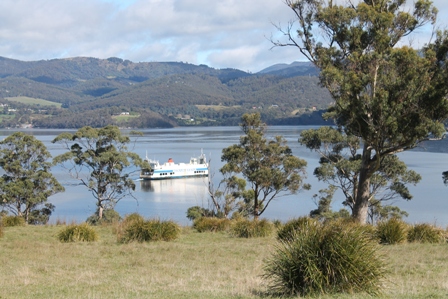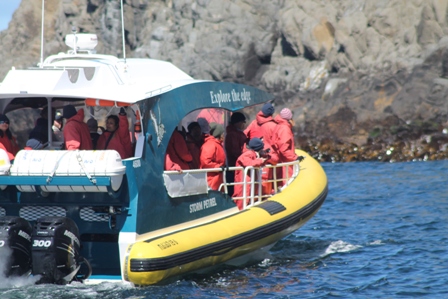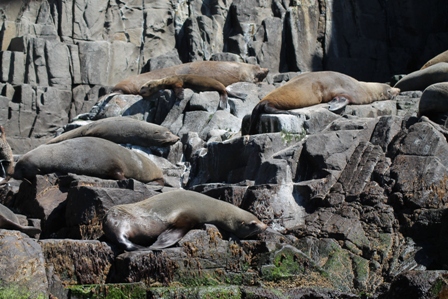13th October 2012
Over the years I’ve heard a lot about Tasmania. In fact, I chose Tasmania as a school project when I was about 11 and bored my friends stupid talking about its wildlife. Now

Bruny Island Ferry, Tasmania, 13/10/12 (Dominic Couzens)
some 20 years later it’s my chance to see what the fuss is about. It turns out it’s a big fuss, and you’ll hopefully see that over the next few posts.
Tasmania is a heart- shaped island plonked 250km south of the mainland of Australia (thanks, Wikipedia). It’s the size of Wales with a population of half a million people (much less than Cardiff), and over a third of the land is protected in reserves. That, plus being almost fox-free, is a recipe for a superb place for wildlife. The landscape is hillier and fresher-looking than much of Australia, and the climate is cooler and far more changeable. If there weren’t Eucalypts and loads of wallabies, you could imagine you were somewhere else. When we arrived there was still springtime snow on the hilltops.
On the south-east coast of Tassie is Bruny Island which, apart from being popular for day-trippers from Hobart, is also the birding headquarters, because every one of Tasmania’s 12 endemic (unique) bird species occurs here. It’s also the home of Tonia Cochran, Tasmania’s foremost bird guide, and our guide for the week.
Schedules demanded that we couldn’t be unleashed upon the endemics until taking a ride offshore on a Bruny Island Cruise, setting off from the enticingly named Adventure Bay, an anchorage used both by Captain Cook in 1777 and by Bligh in 1788 – the latter on the infamous Bounty. There were no mutinies today, however, as we chugged along the

Bruny Island Expeditions boat (Dominic Couzens)
choppy coastline -but then let’s face it, being shown Black-faced Cormorants is a lot more agreeable than being keel-hauled. The tourist boat paid homage to the caves, cliffs and stacks, and made its way towards the Friars rocks, where there was a medium-sized colony of Australian Fur Seals in residence. As you can see

Australian Fur Seals, The Friars, Bruny Is, Tasmania, 13/10/12 (Dominic Couzens)
from the photograph, our visit caused pandemonium and uproar among them – or maybe not. Actually, the only uproar was in the currents, for this is where the Tasman Sea meets the Great Southern Ocean (as the locals insist on calling it, as if there was a Great Northern one), and it was decidedly unsteady. It was now a choice between being seasick or enjoying the increasingly exciting marine animals – lots of Shy Albatrosses, many Short-tailed Shearwaters, some auk-like Common Diving-Petrels and, briefly, 2-3 Short-beaked Common Dolphins playing in our wake.
In the cafe after our voyage the waiter looked aghast when I had the temerity to order a latte with my meal, as if to say “What, mate?” Evidently Tasmania isn’t yet civilised, and Captain Cook would turn in his grave.
Talking of the explorer, our next stop happened to be at the somewhat grandiosely named Captain Cook Caravan Park. Here some tall Tasmanian Blue Gums next to Adventure Bay were playing host to small, very excitable, fidgety flocks of Swift Parrots. It was hard to get a good view, making us fidgety and excitable too, but eventually we managed to see them well, and appreciate their slightly odd colour scheme. They look rather as though they have borrowed some bright patches from other parrots – a blue forehead here, purple tail there, red and blue on the wings etc – to add on to their plain green, and it doesn’t quite work. However, these parrots are special. They breed only in Tasmania and migrate in the winter to a broad swathe of south-east Australia, where they are nomadic. Being a migratory parrot in Oz is not a good career move (see next post), and these birds are now endangered, with a world population of fewer than 2500 adults.
Much of the afternoon was taken up with finding Tasmania’s endemic species. The forest walks around nearby Mavista Nature Reserve eventually yielded what is regarded as the trickiest one to find, the Scrubtit, as well as the Tasmanian Thornbill (like a Brown Thornbill wearing leggings) and the Tasmanian Scrubwren. This was also a good spot for the Tasmanian leech – just ask Mike – but I don’t know if that particular species is endemic. A pair of Green Rosellas by the police station completed the festivities.
Just in case this trip isn’t sounding enough like hard work, you should know that we didn’t stop birding after dinner, but made the short trip down to the neck of land between the two parts of Bruny Island to check out the Little Penguin colony. In the darkness and the rain, our progress along the boardwalk wasn’t much better than the penguins’ themselves, but we saw them well and heard their calls, a cross between a bray and a trill. The penguins, as well as the Short-tailed Shearwaters here, come to their colonies from the sea only in the darkness, to avoid predation. And no wonder: both are awkward and vulnerable in places like beaches and sand-dunes.
